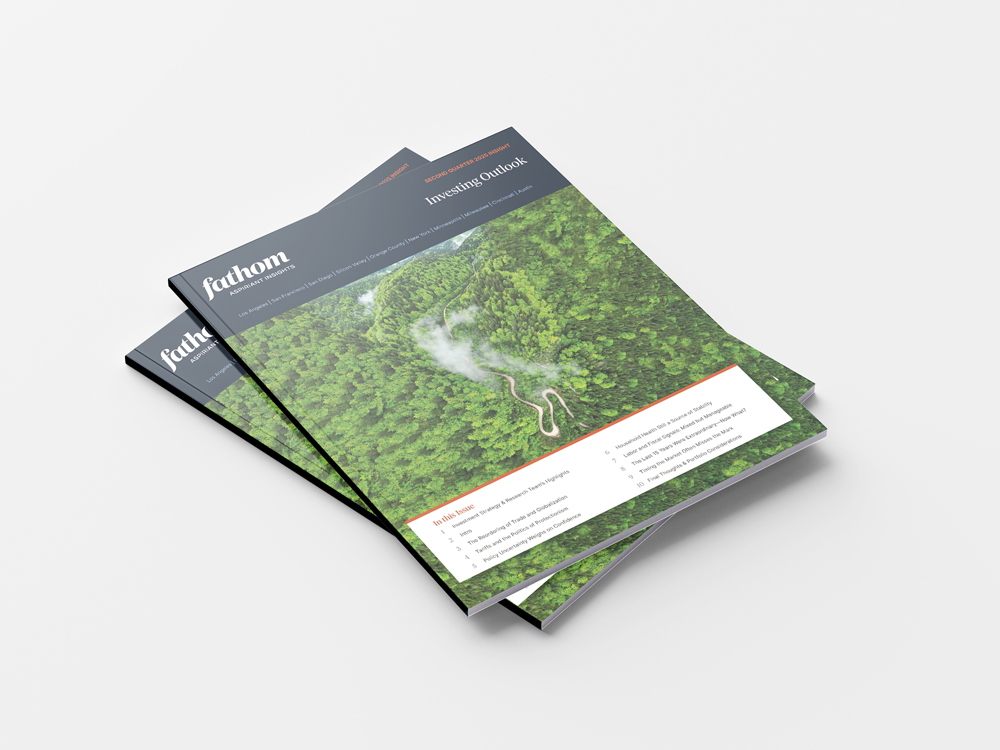
Investment Strategy & Research (IS&R)
Explore key insights from our Investment Strategy & Research (IS&R) team’s second-quarter 2025 market outlook. This brief touches on shifting global trade dynamics, policy uncertainty, consumer and labor trends and how they shape long-term investment strategy. For a deeper dive, access the full Insight.
Highlights
- Global Trade Realignment Is Underway: A shift toward protectionism is reshaping global commerce, with U.S. policymakers emphasizing domestic production and industrial resilience over cross-border efficiency.
- Mixed Policy and Economic Signals Cloud Outlook: While employment and household finances remain stable, proposed tariffs, a large deficit and increased uncertainty weigh on sentiment, raising concerns about fiscal flexibility in a downturn and further complicating late-cycle forecasts.
- Past Performance May Mislead Future Expectations: Strong equity outperformance over the past 15 years reflects historically low rates and expansive policy—conditions unlikely to persist.
- Discipline Outperforms Reaction: Empirical evidence continues to show that staying invested in a diversified portfolio through market cycles yields better results than market timing.
Macro Environment at a Glance
The Reordering of Trade and Globalization
Markets in 2025 are contending with a meaningful shift in the global economic order—one defined by rising economic nationalism and a retreat from decades of globalization. In the U.S., policymakers are increasingly prioritizing industrial resilience and domestic production over cross-border efficiency, fueling a broader reorientation of trade policy.
One of the clearest expressions of this shift is the Trump administration’s recently proposed tariff package. Initially projected to raise the average effective tariff rate from 2.5% to as high as 25% across U.S. trading partners, subsequent negotiations with more than 50 countries—including China—have tempered estimates to a 10% to 20% range.
While elevated by modern standards, Figure 1 shows that tariffs at or above these levels were historically common during earlier periods of U.S. protectionism.
We remain in the early stages of this transition. The long-term effects will depend on how costs are shared across supply chains. Producers may absorb some pressure, but for essential or specialized goods, consumers could face higher prices. In either case, trade barriers typically reduce transaction volume, slow economic growth and add friction to an already complex system.
Recalibrating Market Expectations After Unprecedented Tailwinds
Adding to today’s sense of unease is the shadow cast by an unprecedented stretch of market performance. From 2010 through 2024, U.S. large-cap equities delivered the highest rolling 15-year excess return over short-term government yields—typically measured by 3-month Treasury bills—since 1950, more than double the historical average, as illustrated in Figure 2. For many investors, this era redefined what market success can look like.
This outperformance was underwritten by an unusually accommodative policy environment. Interest rates remained below 1% for much of the period, while the Fed expanded its balance sheet by over $5 trillion through quantitative easing. Fiscal policy was similarly expansive, with deficits averaging more than twice the historical norm. At the same time, equity markets were reshaped by the rise of dominant technology platforms, as a handful of mega-cap firms— publicly traded companies with market capitalizations typically over $200 billion—now make up nearly 30% of the S&P 500 and account for more than $17 trillion in market value added since 2009.
Though supported by strong fundamentals, these gains were amplified by stretched valuations and a historically low cost of capital—conditions unlikely to persist. As a result, today’s unease reflects not only geopolitical or policy risks, but the broader challenge of recalibrating expectations after an extraordinary period of market growth.
Final Thoughts & Portfolio Considerations
- Market Timing Often Undermines Outcomes: Investors who remain fully invested tend to outperform those who attempt to time the market—a trend supported by Morningstar’s 2024 Mind the Gap study, which links return shortfalls to poorly timed trades. The narrowest gaps occurred in diversified portfolios—highlighting the role of broad exposure in reducing emotional decision-making and capturing return dispersion.
- Prioritizing Resilient Portfolio Positioning: In low-growth, low-inflation environments, nominal bonds and defensive equity sectors—such as utilities and dividend payers—have tended to offer stability. If inflation proves persistent, allocations to healthcare, real assets and inflation-linked bonds may prove more durable.
- Diversification Provides Resilience Across Scenarios: No single portfolio positioning can address every macro-outcome. Broad exposure across asset classes, regions and sources of risk remains the most reliable foundation for achieving long-term objectives.
- Core Principles Endure Structural Shifts: Even as global dynamics evolve and policy constraints grow, time-tested investment frameworks continue to guide decision-making through periods of heightened uncertainty.
| Download Insight brief | Download full Insight analysis |

 Talk to us
Talk to us 






